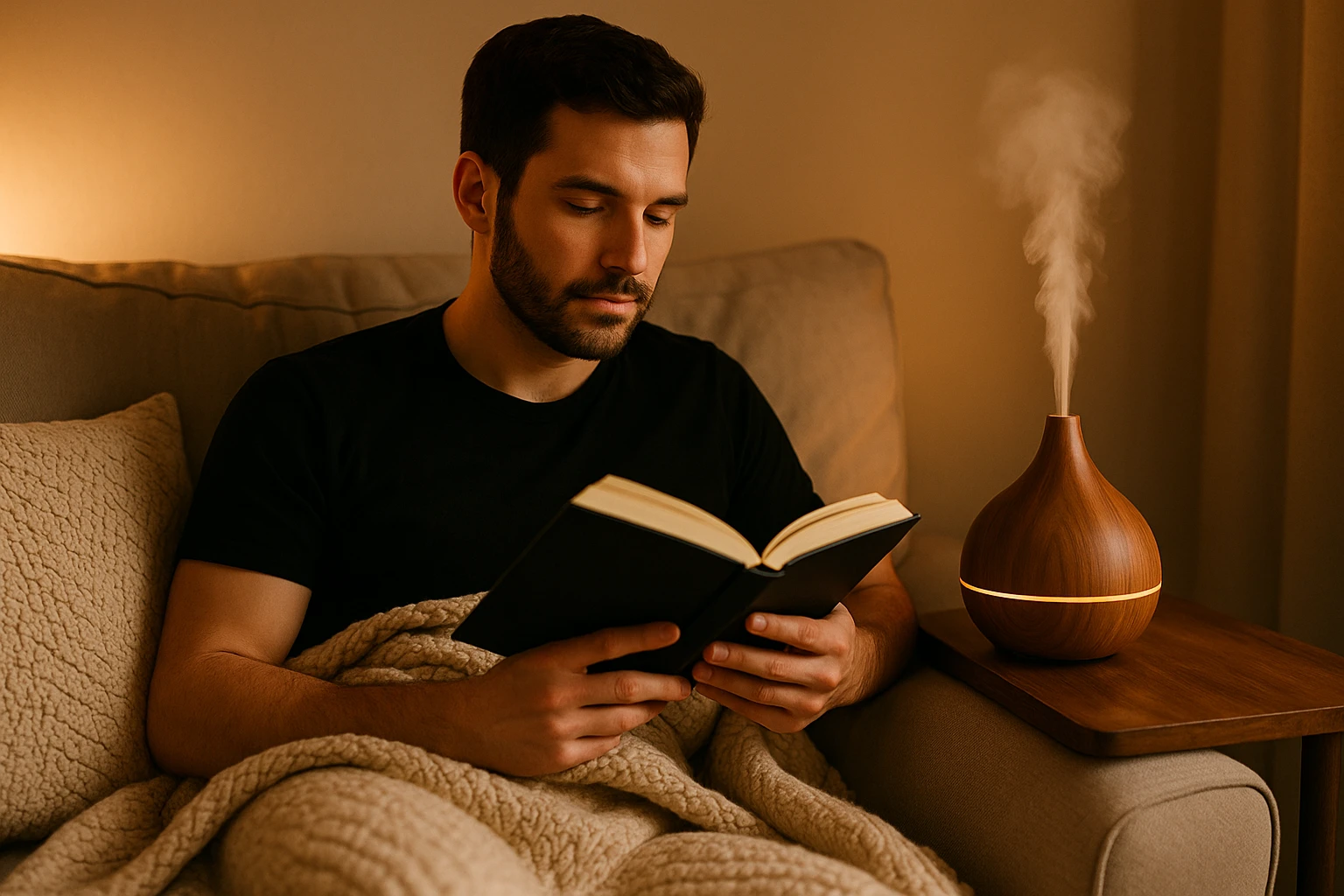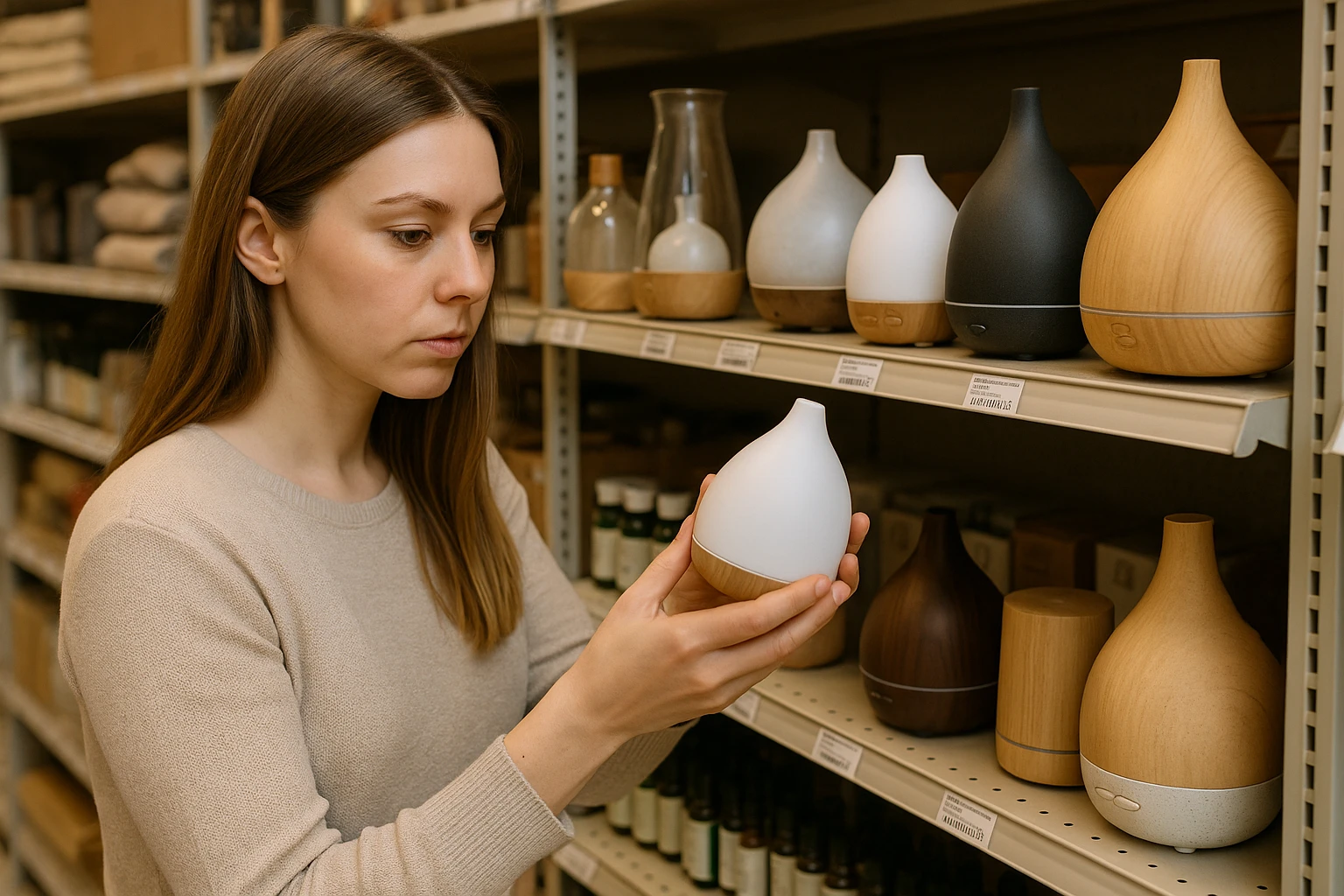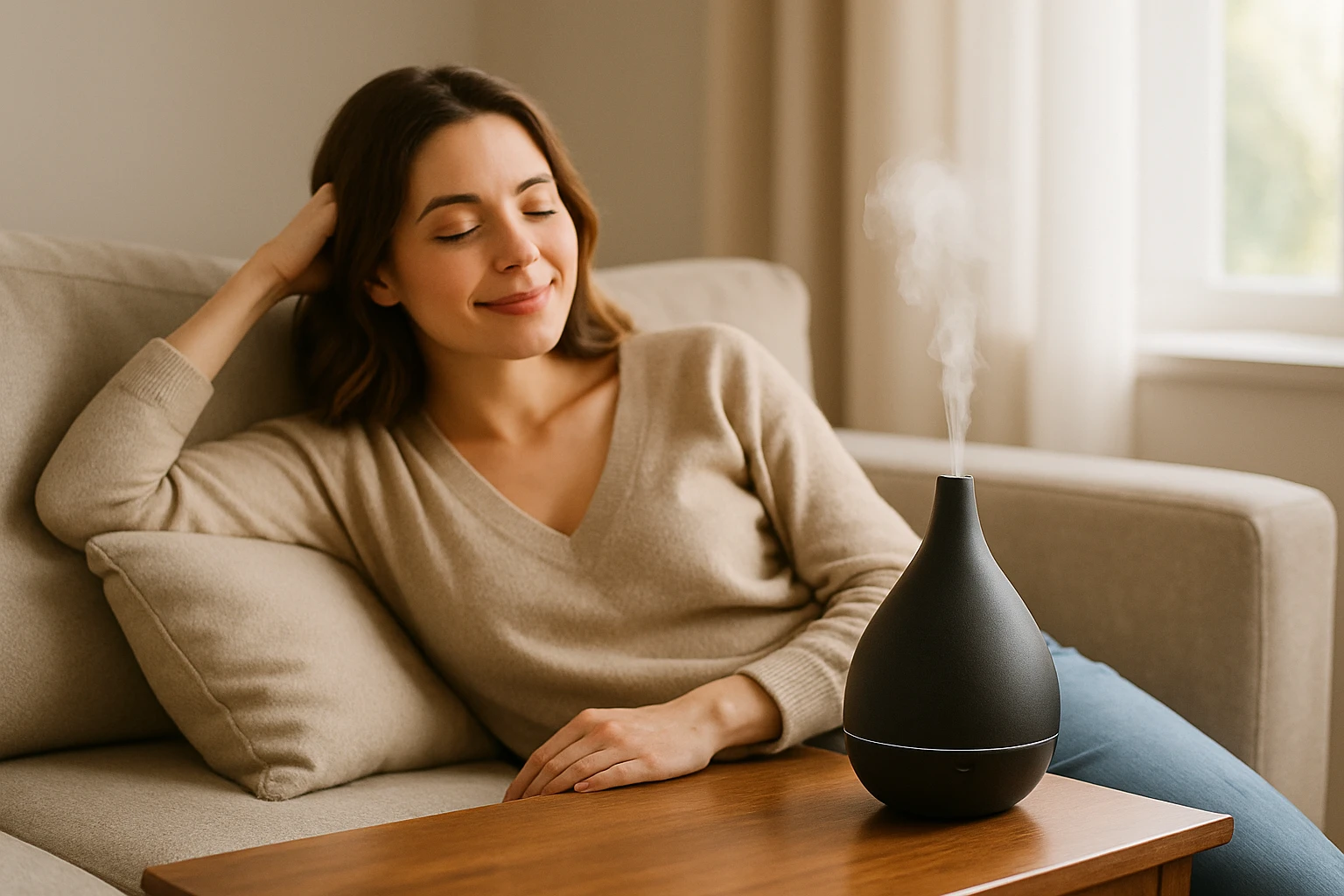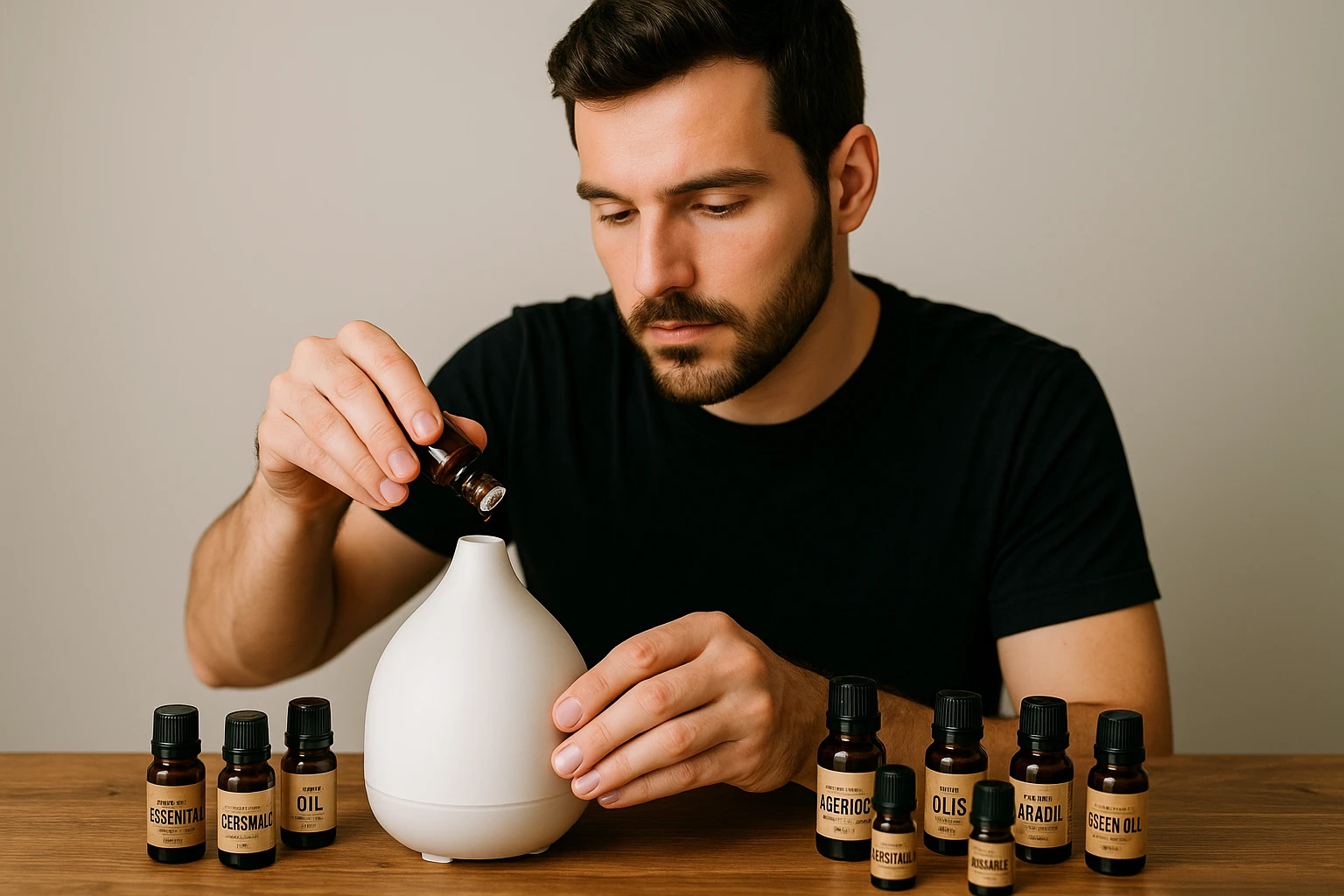Blog sidebar
Category
Recent Posts
- Dec 07, 2025
- Dec 05, 2025
- Dec 05, 2025
- Dec 02, 2025
- Dec 01, 2025
- Dec 01, 2025

The Ultimate Guide to Choosing a Home Essential Oil Diffuser
Contents
Section 1: Introduction to the Value of a Home Essential Oil Diffuser
Imagine returning after a long day to a living space suffused with calm, subtle fragrance—your tension dissolves as botanical aromas weave through the air. Achieving such harmony isn’t about candles or plug‑in fresheners any more; it’s about how a well‑chosen, gentle diffusion system can elevate your home atmosphere. Professional aromatherapists and wellness experts often highlight how an ultrafine mist of essential oils can transform mundane rooms into peaceful retreats.
In contemporary living, where stress and sensory overload are everyday companions, even a brief session with the right diffuser can bring notable psychological relief. A controlled experiment involving university students revealed that inhaling fir essential oil significantly reduced indicators of stress—measured via heart‑rate variability and mood assessments—bringing down tension, depression and fatigue while boosting feelings of vigour PubMed study on fir oil.
Yet, it’s important to balance such benefits against emerging insights into indoor air quality. Scientific studies analysing emissions from ultrasonic diffusion of oils like lemon, lavender and eucalyptus have found measurable quantities of volatile organic compounds (VOCs) and particulate matter, suggesting potential implications for occupants’ health depending on room size, ventilation and usage patterns VOC and particulate emissions research.
This introduction establishes the foundation for a comprehensive exploration of how to select, use and maintain a home essential oil diffuser wisely—so you reap wellbeing rewards while staying mindful of air quality. In the sections that follow, actionable insights will address choosing safe oils, optimising diffusion routines, and ensuring you enjoy the therapeutic potential of aromatherapy without compromising comfort or health.
2. Understanding the Benefits and Risks of Diffusing Essential Oils
Continuing from our introduction, it’s useful to examine both the therapeutic possibilities and the air quality considerations associated with a home essential oil diffuser. While the scent of lavender or citrus can enhance your living space, the science underscores both calming sensations and the need for cautious use.
Potential Wellbeing Benefits
Emerging evidence suggests diffusing certain oils may support relaxation and cognitive focus. For instance, lavender inhalation has been linked to improved deep wave sleep and restful quality before bedtime, while rosemary and peppermint oils are noted for boosting mood, memory, and alertness. Oils like eucalyptus and tea tree are recognised for their anti-inflammatory or antimicrobial traits, which may subtly support respiratory comfort and cleanliness when diffused Yuemi Health Benefits of Diffusing Essential Oil Modern Diplomacy report.
Air Quality and Safety Considerations
However, alongside these benefits, scientists and environmental health experts highlight potential downsides. Ultrasonic diffusers can release volatile organic compounds (VOCs) and fine particulate matter (PM), with studies showing emissions such as d-limonene, eucalyptol and linalyl acetate at measurable rates PubMed study. Prolonged exposure—especially in unventilated or small spaces—has been associated with respiratory irritation, worsened asthma symptoms, and cognitive effects like impulsivity or reduced memory sensitivity IAQ.Works analysis PubMed cognitive function study. The American Lung Association cautions that essential oil diffusion may impair indoor air quality, particularly for individuals with respiratory conditions American Lung Association. Prominent researchers such as Anne C. Steinemann also report fragranced products often emit undisclosed hazardous chemicals that can adversely impact health Steinemann’s research.
Comparison of Benefits vs Risks
| Aspect | Potential Benefit | Associated Risk |
|---|---|---|
| Relaxation & Sleep | Lavender may improve sleep quality | Overuse may result in respiratory irritation |
| Cognitive Enhancement | Peppermint and rosemary can aid alertness | High VOCs may impair memory or increase impulsivity |
| Clean Air & Antimicrobial Effects | Tea tree and eucalyptus have antimicrobial properties | Diffused VOCs/PM may degrade air quality over time |
By balancing the desirable sensory and mood-enhancing qualities of aromatherapy with precise attention to ventilation, oil selection, and diffusion duration, you can craft a thoughtful approach. In the next sections, we will explore actionable strategies to choose safer oils, adopt optimal dosage routines, and ensure hygienic maintenance, so that your aromatherapy experience remains beneficial and health-conscious.

Section 3: Scientific Insights – Proven Benefits of Aromatherapy at Home
Continuing from our relaxing scene-setting, it’s time to explore the evidence-based benefits of incorporating an essential oil diffuser into your daily routine. Drawing on recent research and expert advice, this section offers actionable insights into how a home essential oil diffuser can elevate wellness, mood, and air quality.
1. Enhancing Sleep and Reducing Stress
Numerous studies show that diffusing oils such as lavender, bergamot, and sandalwood triggers the release of calming neurotransmitters, helping to lower cortisol levels and promote deep, restorative sleep. For example, research indicates that the aromatic cues from these oils can help regulate sleep-wake cycles by signalling to the brain that it’s time to wind down. Many sleep clinics now integrate such aromatherapy into their protocols to reduce reliance on sleep aids Airomatica, 2025 airomatica.com.
2. Air Purification and Immune Support
Beyond aesthetics, essential oils like tea tree, eucalyptus, and lemon possess natural antimicrobial properties. When atomised, they effectively reduce airborne pathogens, offering a healthier alternative to chemical air fresheners. Innovations in diffuser design even allow for antimicrobial efficacy without increasing humidity—a significant advantage for homes prone to mould Airomatica, 2025 airomatica.com.
3. Boosting Focus, Cognition, and Mood
Studies suggest that diffusing oils such as peppermint, rosemary, and citrus blends can sharpen focus, improve memory, and foster clarity—making diffusers especially useful for home offices or study areas. Additionally, uplifting scents like jasmine or citrus can stimulate emotional centres of the brain, lifting mood and reducing mental fatigue AromaLeap aromaleap.com.
4. Practical Usage Tips for Maximum Effect
- Use bedtime protocols—such as diffusing 6–8 drops of a lavender blend for 30 minutes before sleep—for optimal tranquillity and sleep support Charabanc Aroma charabancaroma.store.
- Apply intermittent diffusion cycles (e.g., 10 minutes on, 20 minutes off) to maintain therapeutic impact and prevent olfactory fatigue Charabanc Aroma charabancaroma.store.
- Select pure, therapeutic-grade oils to ensure potency, safety, and desired effects—especially for sensitive household members.
By pairing research-backed protocols with thoughtful oil selection and diffuser usage, your diffuser becomes more than decor—a tool for scientifically grounded wellbeing.
Understanding the Benefits of Aromatherapy with Essential Oil Diffusers
Aromatherapy has gained substantial recognition for its potential benefits, chiefly facilitated by the use of a home essential oil diffuser. These devices help in dispersing essential oils into the air, allowing for the absorption of natural compounds into the body through inhalation. This process is believed to promote various health benefits ranging from stress relief to enhanced sleep quality.
Stress Reduction
A substantial body of research supports the use of aromatherapy for stress alleviation. For example, a study published in the "Journal of Clinical Psychology" found that participants who engaged in regular aromatherapy reported a notable decrease in stress levels [source]. Lavender, a popular choice in home essential oil diffusers, is particularly known for its calming properties. By diffusing lavender oil, users can create a serene atmosphere that encourages relaxation and calmness.
Improved Sleep Quality
One of the most sought-after benefits of using a home essential oil diffuser is the improvement in sleep quality. According to a study in the "Evidence-Based Complementary and Alternative Medicine" journal, participants exposed to lavender oil via a diffuser reported better sleep quality and increased duration [source]. Diffusing oils before bedtime can set a relaxing tone for the evening, making it easier to drift into a restful sleep.
Boosting Mood and Concentration
Beyond relaxation and sleep, essential oils are also credited with uplifting mood and enhancing concentration. Citrus oils like lemon and orange are renowned for their invigorating properties. By using these oils in a home essential oil diffuser, individuals can foster a positive environment that increases alertness and productivity. A study in "Industrial Health" observed that the diffusion of lemon oil in a workplace improved cognitive performance and mood among employees [source].
Incorporating a home essential oil diffuser into daily routines can thus be a valuable addition to one's lifestyle. By selecting oils tailored to specific needs, users can harness the full potential of aromatherapy for holistic benefits. The evidence underscores its versatility from easing stress to creating a conducive work environment, making it an essential tool in modern well-being practices.

Choosing the Right Home Essential Oil Diffuser for Your Needs
When it comes to selecting the ideal home essential oil diffuser, the options can seem overwhelming due to the variety of models available on the market. Understanding your specific needs and preferences is crucial in making an informed decision. Here, we explore key factors to consider and how they enhance your aromatic experience.
Types of Diffusers
Essential oil diffusers come in several types, each with unique benefits. The most common types include ultrasonic, nebulising, evaporative, and heat diffusers. Ultrasonic diffusers are popular for their ability to humidify the air while dispersing oils. In contrast, nebulising diffusers provide a more potent aroma as they use pressurised air to disperse the oils, which can be advantageous for therapeutic settings. Understanding these differences will ensure your choice aligns with your desired atmosphere.
Room Size and Coverage
Consider the size of the room where you intend to use the diffuser. Larger spaces may require a unit with a higher capacity to effectively distribute the scent. For example, a nebulising diffuser could be suitable for expansive living areas, providing a more concentrated aroma over a wide range. According to Healthline, evaluating the square footage of your room will help in choosing the right model, ensuring optimal performance without overusing essential oils.
Time and Intensity Settings
The flexibility of time and intensity settings is another critical factor. Many modern diffusers offer variable settings that allow you to customise the duration and strength of the fragrance. This feature is especially beneficial if you prefer a subtle scent during the day and a more robust aroma at night. An adjustable timer ensures the device suits your lifestyle, conserving oils and energy efficiently.
Material and Design
The material and aesthetic design of the diffuser can complement your home decor, enhancing the overall ambience. Sleek designs made from natural materials like wood or ceramic can add a touch of elegance to your space. Additionally, opting for BPA-free materials ensures safety, aligning with health-conscious choices. A thoughtful selection of materials and design can transform your diffuser into a stylish focal point.
The key to finding the perfect home essential oil diffuser lies in balancing functionality with personal preference. By weighing these factors carefully, you can create an atmosphere that aligns with your lifestyle and personal tastes, as confirmed by guidance from AromaWeb.
Section 6: Safety Considerations and Responsible Use
Following on from understanding the benefits of a home essential oil diffuser, it’s imperative to address safety considerations to ensure a truly beneficial experience. While such devices can offer stress relief, improved sleep and enhanced mood, these advantages must be balanced with mindful, informed use.
Quality Control and Regulation
First, be aware that essential oils are not tightly regulated, meaning purity may vary significantly between brands. For instance, the American Lung Association warns that essential oils may release volatile organic compounds (VOCs), which can irritate the respiratory system—especially for individuals with asthma or COPD—and may even elevate heart rate or blood pressure with prolonged exposure lung.org. Therefore, selecting reputable brands that provide third‑party testing or GC‑MS reports is prudent.
Potential Health Risks
Scientific literature indicates that diffusing essential oils can influence indoor air quality. A study using an ultrasonic diffuser found that despite quicker reaction times in participants, there were also trade-offs in impaired memory sensitivity and reduced response inhibition—suggesting potential cognitive downsides pubmed.ncbi.nlm.nih.gov. Additionally, some oils such as lavender or tea tree have been linked to endocrine effects in certain populations—highlighting why more research is needed and why caution is advised time.com.
Practical Guidelines for Safe Use
- Always diffuse in a well‑ventilated space and avoid continuous operation. Experts recommend running the diffuser in 30–60 minute intervals to prevent overexposure.
- Use minimal quantities—typically 3–5 drops per 100ml of water—to minimise VOC concentration while still enjoying the aroma.
- If you or someone in your household has respiratory sensitivities, consult with a healthcare professional before using any diffuser, especially in enclosed rooms.
Special Populations and Users
Caution is particularly important for vulnerable groups such as children, pregnant or breastfeeding women, and pets. The National Institute of Environmental Health Sciences notes that compounds in essential oils may act as endocrine disruptors, emphasising the need for moderation or avoidance in these groups time.com. Furthermore, those with known allergies should perform a test with minimal diffusion before wider use.
Overall, while implementing a home essential oil diffuser can elevate home ambience and support well‑being, users should approach diffusion with due care. Conscious choices regarding oil quality, diffusion duration, and household circumstances ensure that aromatherapy remains a joyful, health‑enhancing ritual, not a source of unintended harm.

Section 7: Market Trends and Consumer Insights
Gaining clarity on how a home essential oil diffuser fits into broader market and lifestyle trends provides valuable insight for both brands and consumers. Recent reports show that the global home fragrance diffuser market was valued at approximately USD 2.96 billion in 2024, with projections to reach USD 4.79 billion by 2034, growing at a CAGR of 5.5%—this reflects increasing consumer interest in wellness-enhancing home environments Emergen Research, 2025.
Zooming in on North America, the value of the aromatherapy diffuser market reached around USD 490 million in 2025, and is expected to climb to USD 688 million by 2030, corresponding to a CAGR of 7.0%. This growth is largely driven by rising engagement in self-care routines and the integration of smart home features such as voice control and app scheduling Mordor Intelligence, 2025.
On the consumer side, spa and wellness environments are pioneering the use of high-end diffusers, which in turn influences residential adoption. With over 182 million spa visits recorded in the U.S. in 2023, according to the International Spa Association, diffusers have become synonymous with relaxation and therapeutic atmosphere in commercial settings—this spillover effect is encouraging at-home usage Mordor Intelligence, 2025.
Moreover, evolving product innovation is evident: hybrid devices that marry ultrasonic misting with nebulising technology are gaining traction, offering both moisture and pure aromatic delivery. These trends are being driven by consumer demand for multifunctional and aesthetic wellness devices Emergen Research, 2025.
For those crafting content around a home essential oil diffuser, these industry insights present numerous opportunities. Demonstrating how such devices tap into wellness, smart living, and luxury spa-inspired trends showcases not only current consumer priorities but positions your offering as both functional and aspirational. Transitioning seamlessly from earlier practical advice, this section lays groundwork for exploring design considerations, safety guidelines, or buying recommendations in subsequent chapters.
8. Practical Guidelines for Safe, Effective Use
Moving naturally from earlier discussions, this section focuses on the safe and effective application of a home essential oil diffuser, drawing from scientific research and best practice guidance. It’s essential to understand how to maximise benefits while mitigating risks—whether for wellbeing, ambiance, or functionality.
Effective Diffusion Techniques
Consistent intermittent schedules prove more effective than continuous operation. Research indicates that olfactory receptors become desensitised after 30–60 minutes of continuous exposure, so diffusing in intervals such as 30 minutes on followed by 30 minutes off helps sustain therapeutic impact and prevents sensory fatigue Oil Diffusers Safety Guide. Similarly, the Charabanc Aroma approach of 10-minute diffusion cycles enhances mood while avoiding overexposure Charabanc Aroma.
Ventilation and VOC Considerations
When diffusing essential oils, especially in poorly ventilated spaces, VOC concentrations can rise—up to 60% in just two hours according to a 2023 study from the University of California. Such levels may lead to respiratory irritation or generate harmful secondary chemicals Tips for Safety. To maintain safe air quality, always ensure proper ventilation—open a window or use an exhaust fan—and limit continuous diffusion periods.
Choosing the Right Equipment
The type and quality of diffuser significantly influence safety and efficacy. Nebulising diffusers emit undiluted essential oils and offer strong therapeutic dispersion, but they demand cautious use due to higher VOC output, especially in confined spaces BedroomLab discussion. Ultrasonic models are more moderate, but require regular cleaning to prevent bacterial growth and degradation of oils Diffuser Essentials. Opting for materials like medical-grade plastic, glass, or ceramic reduces the risk of contamination and preserves oil purity.
Special Population and Environmental Safety
Certain demographics and living conditions necessitate heightened caution. Diffusing oils like eucalyptus, peppermint or cinnamon around young children, people with respiratory conditions, pregnant women, or pets can pose health risks. For example, cats lack certain liver enzymes and often react adversely to many essential oils Oil Diffusers Safety Guide. In such cases, reduce concentration, limit duration, and consult healthcare or veterinary professionals when needed.
Maintenance and Longevity
Proper maintenance ensures safety and prolongs diffuser life. Avoid leaving water or oil residue for more than a day to reduce microbial growth, and follow manufacturer cleaning guidelines diligently—this often involves weekly vinegar-based cleanings and daily rinses Diffuser Essentials. Regular cleaning supports optimal performance and protects both the device and indoor air quality.
Through mindful scheduling, ventilation, equipment selection, population-specific precautions, and maintenance, this guidance ensures that your aromatherapy experience remains both safe and beneficial—setting the stage for sections ahead focused on selecting, designing, and buying the ideal diffuser system.

Section 9: Safety Considerations and Best Practices
Ensuring a safe and beneficial experience with your home essential oil diffuser requires attention to quality, usage, and individual sensitivities. While incorporating aromatherapy into daily life offers many perks, observing best practices is vital to mitigate potential risks.
Choose High-Quality Oils
Begin with pure, reputable essential oils. Impurities or synthetic additives may compromise effectiveness and pose health risks. Experts advise selecting oils labelled as “100% pure” or certified organic, ideally from brands that support third-party testing. This ensures you’re diffusing safe, uncontaminated products.
Avoid Overexposure
Diffusing continuously, especially in poorly ventilated spaces, can lead to irritation or diminished cognitive clarity. One user reported using around 30 drops instead of the recommended 3–5, resulting in symptoms like light-headedness and “brain fog.” It’s essential to follow manufacturer guidelines and maintain good ventilation to prevent adverse effects.
Use Intermittent Diffusion for Effectiveness and Safety
Rather than running the diffuser constantly, an intermittent cycle—such as 10 minutes on and 20 minutes off—can preserve both therapeutic benefits and oil longevity. Expert aromatherapist Robert Tisserand notes that intermittent use is safer and more effective than continuous diffusion, and many programmable diffusers now offer this functionality.
Be Mindful of Respiratory Sensitivities
Essential oils may release volatile organic compounds (VOCs) that irritate the airways. The American Lung Association cautions that some diffused oils can exacerbate symptoms for those with asthma or COPD, and prolonged use may affect heart rate or blood pressure. If you have respiratory conditions, consult a medical professional before using a diffuser, and always ensure proper dilution and ventilation.
Consider Pets and Children
Not all members of the household may tolerate diffused scents equally—pets and young children may be especially sensitive. Always observe their reactions and limit exposure accordingly. Avoid placing diffusers within their reach or running them in enclosed, small spaces without fresh air flow.
Maintenance Is Essential
Keeping your diffuser clean is crucial. Residue buildup may foster mould or affect scent performance over time. Clean the water reservoir after each use and perform a deeper clean weekly with a mild vinegar solution or as directed by the manufacturer to ensure continued safe operation.
Summary of Safe Diffusion Practices
- Opt for high-quality, certified oils.
- Follow recommended oil drop counts and avoid excessive use.
- Use intermittent diffusion cycles to prevent sensory fatigue.
- Ensure good ventilation, especially for respiratory-sensitive individuals.
- Monitor reactions from children and pets.
- Maintain regular cleaning to prevent buildup and contamination.
By attentively following these safety measures, you can harness the many advantages of diffusing—whether for relaxation, focus, or ambience—while maintaining a healthy, comfortable environment for everyone in your home.
Key sources: The American Lung Association warns of VOC-induced respiratory and cardiovascular risks from diffused oils. (American Lung Association) Real-world reports detail cognitive fog following excessive diffusion, highlighting the importance of moderation.
10. Best Practices for Safe and Effective Usage
Building on our earlier discussion of respiratory risks associated with poorly managed diffusion, it’s essential to establish clear, actionable guidelines for using a home essential oil diffuser safely and effectively. Evidence-based practices can significantly reduce the potential for irritation, overexposure, and indoor air pollution.
1. Moderate Diffusion Durations
Instead of continuous operation, run your diffuser in intervals—typically 30 to 60 minutes on, followed by an equal or longer break. This approach honours therapeutic benefit while limiting cumulative exposure to volatile organic compounds (VOCs) and reducing habituation of the senses diffuseressentials.com. A population-based study showed that light usage (under one hour per day) may help reduce blood pressure and heart rate, whereas long-term excessive exposure could pose cardiopulmonary risks mdpi.com.
2. Choose High-Quality, Pure Oils
Quality matters: opt for oils labelled 100% pure and produced using clean distillation methods, avoiding synthetic additives. Low-quality or adulterated oils may contain harmful chemicals like diacetyl or unknown VOCs, which can irritate the lungs or contribute to indoor air pollution health.com.
3. Ensure Proper Ventilation
Always operate your diffuser in well-ventilated spaces. Opening windows or using fans helps mitigate accumulation of VOCs and other airborne irritants. The French Agency for Food, Environmental and Occupational Health & Safety (ANSES) warns that essential-oil based diffusers can contribute to indoor air pollution and cause eye, throat and nose irritation if spaces are poorly ventilated anses.fr.
4. Mindful Placement and User Sensitivities
Place diffusers centrally in well-ventilated rooms and away from sensitive groups such as children, pets, pregnant individuals or those with asthma or COPD. Certain oils—like eucalyptus, peppermint or phenol-rich oils—can be especially irritating and may even provoke respiratory distress health.com.
5. Clean and Maintain the Device
Frequent cleaning is a must. Stagnant water and oxidised oils foster microbial growth or off‑odours and compromise both safety and effectiveness. Follow the manufacturer’s instructions for cleaning frequency—typically daily wiping and weekly deep cleans with vinegar or recommended solutions byrdie.com.
6. Monitor Personal Reactions
Every individual reacts differently. If you notice coughing, headaches, throat irritation, or other symptoms, stop use immediately and ventilate the area. Consult a healthcare professional before resuming. Persons with pre-existing respiratory conditions should always get personalised guidance lung.org.
By adhering to these guidelines, your diffusion routine will be both calming and conscientious—preserving the delicate balance between aromatherapy benefits and health resilience.

11. Advanced Usage and Safety Considerations
Building on earlier guidance, it’s crucial to adopt refined practices when incorporating a home essential oil diffuser into daily routines. Whether used in relaxation settings or more public areas such as offices, thoughtful application ensures both effectiveness and safety.
Smart Placement and Intermittent Diffusion
Rather than running your diffuser continuously, consider intermittent sessions to reduce overexposure. A clinical aromatherapist advises limiting diffusion to around 30 minutes at a time, followed by a break and good ventilation—especially in shared or enclosed spaces—to avoid headaches or nausea, while still reaping benefits from oils like clove or cinnamon blends when used judiciously.
(Source: Best Practices for Using Essential Oil Diffusers)
Quality Oils and Technological Enhancements
Selecting high-quality essential oils is paramount. Synthetic or adulterated oils may not deliver the expected therapeutic outcomes and could even cause irritation. Utilizing reputable brands ensures authenticity of components like pure lavender, eucalyptus, or citrus extracts.
Moreover, some modern diffusers now feature integrated air purification technologies—such as HEPA filtration, UV sanitisation, or activated carbon. These innovations can help mitigate the build-up of volatile organic compounds (VOCs) and microbial contaminants, enhancing overall safety for individuals with respiratory sensitivities or allergy concerns.
(Sources: Consumers on oil quality; Advanced aromatherapy wellness strategies)
Balancing Benefits with Air Quality Risks
While many essential oils possess antimicrobial or mood-boosting properties, their diffusion can introduce VOCs into the indoor environment, potentially compromising air quality. Research has demonstrated that diffusers can release hundreds of VOCs, including potentially hazardous compounds, and may exacerbate symptoms in individuals with asthma or allergies.
That said, integrating ventilation strategies or pairing diffusion sessions with purification technology can make the application of aromatherapy safer without sacrificing its advantages.
(Sources: Essential oils and indoor air quality risks; American Lung Association on essential oil safety)
Final Takeaways
- Use your device in short bursts—about 30 minutes—rather than continuously, and ensure adequate fresh air circulation.
- Always opt for high-quality, authentic essential oils and consider advanced diffusers that include filtration or sanitisation features.
- Be mindful of potential VOC emissions; pair diffusion with air quality strategies for health-conscious environments.
Together, these approaches elevate the safe, intelligent use of a home essential oil diffuser—helping users enjoy aromatherapy benefits while minimising risks and enhancing indoor wellness.
Conclusion: A Balanced Approach to Aromatherapy
The integration of a home essential oil diffuser into your living space can profoundly impact your well-being and atmosphere. By engaging in mindful and informed usage, you can elevate your daily experience through aromatherapy while ensuring a safe and health-conscious environment. This balance is essential in reaping maximum benefits while mitigating any potential risks.
Taking Action: Enhancing Your Space
To fully enjoy the advantages of a home essential oil diffuser, begin by selecting high-quality oils. These oils should be sourced responsibly, ensuring purity and potency. Consider investing in a diffuser that aligns with your needs, whether it be ultrasonic for quiet operation or nebulizing for concentrated aroma dispersion. Additionally, adopting practices such as using oils known for their therapeutic benefits, like lavender for relaxation or peppermint for alertness, can enhance your experience.
Safety and Sustainability
It's crucial to prioritise safety and sustainability in your aromatherapy practices. Utilising diffusers with filtration capabilities can minimise volatile organic compounds (VOCs) in your indoor air, promoting a healthier environment. Pairing your diffuser use with regular ventilation and air quality strategies further ensures a harmonious coexistence between nature and technology. Healthline highlights the importance of choosing organic oils and understanding their properties to avoid potential allergies or irritations.
A Call to Embrace Aromatherapy
There is transformative potential in using a home essential oil diffuser. Beyond merely scenting a room, it can become an integral part of your daily routine, facilitating relaxation, focus, or energy, depending on your choice of oils. To start your aromatherapy journey, consider exploring communities and resources that share insightful experiences and recommendations. According to The Aromatherapy Council, aligning your use of essential oils with scientific insights can lead to more effective and rewarding outcomes.
By embracing a measured approach, you can not only enrich your personal environment but also contribute positively to your overall lifestyle. Begin today by choosing the right diffuser and essential oils tailored to your specific goals—inviting the nuanced power of aromatherapy into your home.
Recommendations:
Share
YOU MAY ALSO LIKE
- Dec 07, 2025
- Dec 05, 2025
- Dec 05, 2025
- Dec 02, 2025
- Dec 01, 2025
- Dec 01, 2025
- Nov 30, 2025
- Nov 30, 2025
- Nov 29, 2025
- Nov 25, 2025
- Nov 24, 2025
- Nov 23, 2025
- Nov 22, 2025
- Nov 21, 2025
- Nov 21, 2025
- Nov 21, 2025
- Nov 21, 2025
- Nov 21, 2025
- Nov 21, 2025
- Nov 18, 2025
- Nov 18, 2025
- Nov 18, 2025
Category
Recent Posts
- Dec 07, 2025
- Dec 05, 2025
- Dec 05, 2025
- Dec 02, 2025
- Dec 01, 2025
- Dec 01, 2025



















































